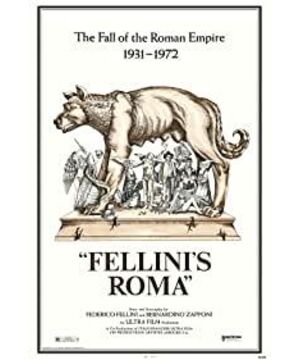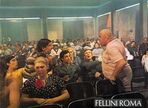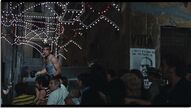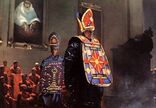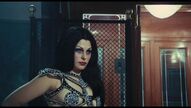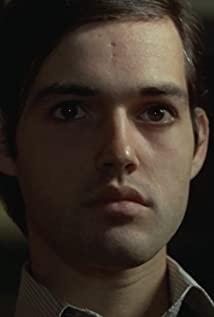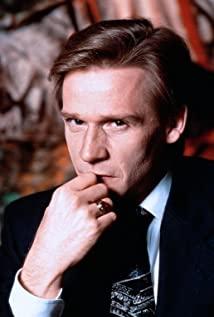1
Someone suggested that Federico Fellini make a movie with a trip to a foreign country as the background, Fellini said in his memoirs. A batch of films of this type emerged in that era. American TV wants to send Fellini to Tibet, India or Brazil to make a film involving religion and local charm. "It's a very attractive proposal. I said it right away, but I knew in my heart that I would not leave. I stayed here very well, so my answer is, I will make a movie about Rome, because I I live in Rome, and I like this city."
Therefore, in 1971, Michelangelo Antonioni traveled across the oceans, walking between Chinese cities and rural areas, and filmed "China" of that era. Federico Fellini created his "Roma" (Roma) with the set set in the studio in Rome Studios .
Not the real Rome, but the Rome that exists in Fellini's heart and belongs to him alone.
At the end of "Rome", when the camera was aimed at an American writer living in Rome, Fellini expressed his feelings for Rome through the mouth of a person. "Rome is a place full of fantasy. There are churches, government, movie theaters, they are all imaginable. We are getting closer and closer to the end of the world because there are too many people, too many cars, and too many drugs. Which city can compare Going to Rome has been reborn so many times? Where is it more peaceful than Rome? This is an ideal city to welcome the end of mankind. I am waiting to see if it will really end."
For Fellini, Rome is an eternal city. Rome is complex and multi-faceted.
"Rome is a horizontal city, with water and soil, lying on the ground, so it is an ideal platform for dreamy soaring."
"Rome is a mother, a perfect mother, because she is indifferent. This mother has too many children, so she has no time to care about you, never asks you for anything, does not expect anything. She accepts you when you come, You are left as you go, like Kafka’s court."
"She can prevent mental illness, but it also inhibits development and true maturity. There are no mental patients, but there are no adults. This is a city of listless, suspicious, and uneducated children, with a little disability, psychologically. , Because hindering development is against nature."
However, Fellini's initial impression of Rome was a stone monument inserted in the soil-"Rome: 340 kilometers". This fragment appears at the beginning of "Rome". Obviously this place is Fellini's hometown, Rimini.
Rimini only gave birth to his womb, and Rome was the real beginning of life. "The first time I saw Rome, I smelled home. I was born on the day I arrived in Rome. Since then, I have never wanted to leave Rome again."
2
Fellini was born in Rimini, a small town on the Adriatic Sea, a summer tourist destination famous for its vast long sandy beaches. However, the excitement of sightseeing is limited to the summer period. As soon as the summer is over, Rimini has become a leisurely country town again.
Fellini's father was born in the country, and his mother was a Roman. He had a desire for Rome since he was a child. With the blood of the Romans, he can't wait to go to Rome as an adult.
Fellini is good at drawing cartoons and writing humorous stories. So after coming to Rome, he drew illustrations or wrote articles for some newspapers and magazines. At that time he lived in no fixed place, sometimes lived in a hotel, sometimes rented an apartment, and lived a bohemian life. Later, with the help of friends, I started to work on column writing, lines, lyrics and script writing.
In 1939, the year World War II broke out, Fellini was preparing to study at the University of Rome, but was able to escape conscription due to an occasional heart attack. But later still had to undergo more stringent conscription inspections by the German army. But his recruitment information disappeared with the destruction of the hospital, and Fellini escaped again. During college, he met Giulietta Masina (Giulietta Masina) who played a role in his play (a student at the University of Rome with Fellini). In 1943, the two married.
Except for living in Florence for a few months, Fellini has never left Rome in his life, and the few experiences of going abroad are compelling. A reporter once recorded in detail his various situations after he arrived in the United States. It made people feel that Fellini leaving Rome was like a fish out of the water, trying to conceal his inner exhaustion with his superficial courtesy.
The experience of his life was written into the movie by him. In the second year of the release of "Rome", he once again aimed the camera at his hometown of Rimini and filmed " Amarcord " (Amarcord, 1973) as the final farewell to his hometown and youth. The most autobiographical film in the early years was " I vitelloni " (I vitelloni, 1953). Fellini poured his memories and emotions into the role of Morado. As an idle young man in a small town, Rimini was in His eyes looked dull and withered. So, at the end of the film, Morado embarked on a train leaving his hometown early in the morning. Where did he go? The trainer asked questions for the audience, but Fellini didn't get an answer. But there is no doubt that his destination is Rome.
In the second year after the release of "Lovers", Fellini co-wrote the script of "Morado in Rome" with two other screenwriters who had been cooperating for many years. This script did not have the opportunity to complete the filming, but became the source of inspiration for La Dolce Vita (La Dolce Vita, 1960). According to the researcher , Fellini finally officially arrived in Rome after the "Langer".
These stories are about Fellini himself, and only "Rome" belongs to Rome. But before "Rome", Fellini actually wrote another Roman story. In 1945, when Fellini was still an unknown person, he was fortunate to be the screenwriter of the famous director Roberto Rossellini. The film was " Roma, città aperta " (Roma, città aperta, 1945). Since then, the 35-year "Golden Era" of Italian cinema (1945-1978) began.
Fellini, who entered the film from Italian neo-realism, is featured in his masterpiece "The Solitude Trilogy"-namely "The Road" (La strada, 1954), "The Liar" (Il Bidone, 1955), and "Kabi" Le notti di Cabiria (1957) still practices the creative principles of neorealism. It's just that his view of "realism also includes inner reality" is different from other neo-realist film creators. However, starting from "Sweet Life", he transitioned from neorealism to symbolism and modernism . His downplaying narrative style, extensive use of mobile photography, pursuit of gorgeous scenery, careful selection of all actors, and a large number of deliberate character modeling all determine the watershed status of "Sweet Life".
As the American film theorist Solomon pointed out, "Fellini is creating a new form of film." The characteristics of this new form can be broadly summarized as: telling movie stories in a way that adapts to modern real relationships and concepts of life, moving towards a new pattern of irrationality, light plots but heavy modality, and situational description.
Regarding the origin of the protagonist Marcelo, only general descriptions are from other provinces. But it is not difficult to recognize Marcelo as Morado in "Langer" . Fellini said in the interview: ""The Tramp" is an ideal ending. Morado came to a big city and became a pivotal reporter. So this film is his adventure as a reporter , combining his Part of my personal life... In a sense, this film is the sum of the many encounters I have experienced in previous years..."
In reality, Fellini has skyrocketed, taking film as a lifelong pursuit and taking the film city as his home. Rome is a movie in his heart.
Years later, Fellini talked about this turning point in his life, and seemed to understate: "I don't seem to have anything to explain. I was born in Rimini, then I came to Rome, then I got married, and then I went to work in the Cinema City. ."
3
The original name of the film is "Fellini's Rome". The first time Fellini put his name in the title was "Fellini-Satiricon" (Fellini-Satyricon, 1969, also translated as "The Myth of Love") a year ago. At that time, it was for legal reasons: there was an Italian film that registered the title "Satiricone" as early as 1962. When the director heard that Fellini was also going to shoot this film, he speeded up his pace and shot it. His version was launched on the market a year earlier than Fellini's version, forcing Fellini to change the title to "Fellini's Satirikon". Once tried, Fellini fell in love with this approach, so there were subsequent "Fellini's Rome" and "Fellini's Casanova" (Il Casanova di Federico Fellini, 1976) .
Adding the director's name to the title does not seem arrogant or pretentious. It may feel different for individuals. Most of Fellini's movies are actually his personal thoughts and confessions. If you really equate "Rome" with a city that actually exists on the map, you would be wrong. As the film critic Roger Ebert said: “Fellini is like trimming his Rome suburbs by the way.”
All city films are selective. From "Berlin-Die Sinfonie der Großstadt, 1927) to "London-The Modern Babylon" (London-The Modern Babylon, 2012), they have chosen a specific location and time, dedicated to framing the scene, and realistic As the basis. But Fellini's "Rome" is different. It mixes the various expressions of the film, with both memories and fantasy; both reality (such as a film crew shooting in a park) and surreal (such as a church costume show) ; There is both the past and the present . There is even a clear narrative thread—what the young Fellini saw and heard when he first came to Rome.
This is the most bizarre movie about the city you have ever seen. It connects a bunch of fragments in jigsaw together like a puzzle. And these fragments do not exist independently, but mutually penetrate and enrich each other. The themes of past Rome can often be found in modern Rome (a few prostitutes are standing in the ruins of Rome). Sometimes Rome of multiple eras coexist in one shot (the train station where the young Fellini played, and Roman soldiers from all eras shuttled around).
Three Fellini appeared in the film: Fellini who went to a church school as a child; Fellini who was 19 years old when he first arrived in Rome; and the current Fellini, with the crew filming in Rome.
A series of short clips are inserted at the beginning to illustrate Fellini’s impressions of Rome in his childhood: ancient Latin lessons in school, slides about Rome, play "Caesar", silent films about gladiators, news films about Rome .
On the platform, the boys stared longingly at a train heading for Rome. After it leaned on the station, it only stopped for a while, and there were no passengers getting on and off. Everything in the lens, young Fellini came to Rome on this train. At this time Italy had just been involved in World War II, and cameras followed him, showing images of Roman soldiers from different historical periods.
He took the tram to a family apartment, where he will share with other users. From then on, Fellini was able to observe Rome from his personal perspective. This apartment can be called a microcosm of the entire city-family-style, disorderly, carnal, people of different identities and social classes live under the same roof.
The heavy firework and various life styles continue in the subsequent street dining paragraphs. In Fellini's eyes, some of the delicacies enjoyed by the Romans were disgusting and charming, such as snails, pasta sauce made from calf intestines, and pig heads with eyeballs. At night, Rome changed to another face: the ancient buildings were silent and gloomy, sheep-driers and flocks were walking down the street, and prostitutes with heavy makeup were standing among the gravel on the outskirts of Rome.
Then cut into modern Rome, the great director Fellini led the film crew to film the scene of the influx of cars into Rome on the outer ring road. This footage, which at first glance looked like a documentary, became more and more eccentric as the rain and night darkened. A white horse ran between the traffic, and tanks appeared. The ruins of ancient Rome on the roadside under the flashing lights became a foil for the huge roar of cars on the highway; a truck caught fire and several cows were killed on the road; near the Colosseum, it was already blocked.
The scene in the park is also happening now. A group of tourists arrived by bus; the students were talking around Fellini and interviewing passers-by.
Time is back to 19-year-old Fellini to watch a performance in the theater, which is a group show just like the scene of dining on the street. People wantonly insulted the actors on stage and praised the actress' big ass. Suddenly there was an air raid warning, and people hid in air-raid shelters.
Then came modern Rome, where the film crew followed the construction team deep underground, and Rome was building a subway. The underground of Rome is huge, like another world. Then one of the most amazing scenes in the whole film appeared. The workers drilled out of an underground palace, and the frescoes and sculptures were all well preserved. However, as the fresh air entered, these precious relics of ancient Rome vanished and turned into dust.
The camera came to Rome in World War II again, this time at the poor streets of Rome. The soldiers patted the team to select prostitutes. They were all low-level prostitutes who were old and faint, but most people still only had a look. The places where young Fellini and his friends go are obviously more advanced, and the clients are also decent people. Fellini spent the spring evening with a black-haired woman and proposed a date.
What happened to Fellini after that, the film did not tell us that Fellini's youth came to an end here. The film later pointed to a mockery of the old aristocracy and the Holy See—the grand, extravagant, and absurd church costume show.
Then the camera returned to the night of Rome, shuttled in the open square, restaurant, market, and stopped for a while among various people. At the end of the film, a large group of motorcycles drove along the streets of Rome. Finally roared through the cave and drove to the outskirts.
It's not that Fellini hasn't made such a loose film before, but "Rome" is fundamentally more open. If you compare it with the 1973 "Amacord", it is not difficult to find the difference between the two. "Amacord" is also composed of a series of fragments, but overall the layout is relatively compact, the narrative paragraphs are closely related, the main characters are prominent, and there is a lot of dialogue. There are also some clear narrative passages in "Rome", but the long and short stories are mixed with montage-style city sightseeing, which is more challenging and experimental for the audience.
4
The fall of Rome is one of Fellini's favorite themes. In the scene in the park, a student wanted to know whether the film would involve major issues facing society today, such as education, factories, and families. "We don't want to see that old, random and messy Rome again." Fellini replied: "I think one should be true to his own essence (to shoot)."
So what is Rome like in Fellini's heart? It is sacred and carnal, eternal but decayed, mother and prostitute. These two opposite qualities not only exist at the same time, but they are also interlinked.
Therefore, Fellini used carnal scenes to symbolize holiness, and vice versa. After the scene of a street feast, the night enveloped Rome, with a few faint blue lights in the set, and a tall prostitute with a full chest stood in the gravel outside of Rome. Prostitutes are usually used to symbolize short time and shallow experience, but here they become eternal. The church, which is usually used as a symbol of eternity, has turned into rubble that disappears over time.
The eternal Rome is collapsing. An angry man in the park accused the director of making the camera most accurate to the ugly side of Rome: "This is no longer Rome. Everyone is too crazy and too rushed. They have become despicable. The real Romans have disappeared! Look around. , All you see are filthy hippies, playful students, transvestites, drug addicts, all kinds of social scum. Don’t forget that this film will be released in foreign countries, how do they think of our lovely Rome!"
In "Sweet Life", Fellini uses a kind of end-time carnival to show the spiritual and moral decline of Rome. He said: "The film is an oil painting, even a mural, it represents a collapse of disaster, a collapse of luxury: the decline of the Catholic empire. "
This collapse appears shocking in "Rome". The construction team discovered an ancient Roman underground palace. The vivid portraits in the murals were sealed by time and become eternal, but once they encounter the air, they will instantly disappear. "They are disappearing! Something has to be done!" said a camera crew. But there is no way, nothing can be done. History is dying, and the spirit of Rome is dying. This scene symbolizes the collision between two Romes: ancient civilization and modern culture. This place inevitably echoes the ending of "Satirikon": the living person finally appears as a portrait on the top of the cliff, letting the wind blow and rain.
"Rome" belongs to the kind of movie that is worth watching repeatedly. I felt puzzled the first time I watched it, and some scenes were inexplicable, but I fell in love with it the second time I watched it. For me, the only drawback is that it is too short. Especially compared to the three-hour film length of "Sweet Life".
In fact, the film should have been much more than it was filmed, and many things in the script were left out: a night game, a football match between Rome and Lazio, a fan lost a bet and had to sneak into the Heroes’ Square. In the fountain... the women of Rome, the summer monsoons and clouds in Rome... all stay outside. The most important thing that was abandoned was a play in the cemetery outside the ancient city wall, where Romans mourned the dead. Like theater plays and dinner plays, it best reflects the Romans’ concept of a big family.
Fellini once said with regret in his memoirs: "In this movie, I have the strange feeling that I have not even touched the surface of the city. Not only is the information not exhausted, but it is intact. I am as excited as before. I made preparations for the land and searched for the most hidden corners, but in the end I found out that the places I thought I had mastered and the human nature were still unexplored, and they were intact. Rome is still pure and innocent, and I made this film about her. It doesn't matter."
WeChat Official Account: Movie Box
View more about Roma reviews


